Using concrete blocks to build beds?
I'm going to be building my raised garden beds soon. After looking at different types of lumber and stuff, I thought of using concrete blocks. They're 8"x8"x16", so I should only need 14 of them per bed, since the beds would only have to be 1 block tall. Has anyone else used concrete blocks? I know they're not very pretty, but they're inexpensive (which is important right now), and I won't have to worry about them rotting. If you've used them (or know someone who has), I'd appreciate any information you can give me. Thanks!
Comments (68)
the_ancient_one
19 years agoCINDER BLOCK GARDENS: The only way to garden, especially when getting up in years. I have been gardening this way for over 20 years. The book CINDER BLOCK GARDENS by Lynn Gillespie, is in my opinon, the bible on how to make it happen. The book covers just about all you will ever need to know about using the "cinder" (old term, I think today, it would be refered to as a "concret") block you have the flexibility to redesign your garden layout whenever you desire. I've never had any problems with "leaking"... if you are watering on a regular basis, the "soil" in the garden will retain what is needed... but if you are a "heavy" waterer, you might experience some leakage... but that is the bed, telling you to lighten up on the water. I have buildt my gardens us to three blocks high... makes it a lot earier to tend the garden when you can park the "behind" on the edge of the bed and not have to stope over so much.
Ray Scheel
19 years agoTAO:
I'll have to see if I can find that book in a library to try to glean some pointers from it. Also, many cinder blocks today *do* still contain fly ash as a major component, so the old term isn't as outdated as one might think, its still the cheapest way for a plant to get rid of a waste product they'd otherwise have to pay to dispose of...
Related Professionals
Glendora Landscape Architects & Landscape Designers · Fairview Landscape Contractors · Medford Landscape Contractors · Newberg Landscape Contractors · Palos Verdes Estates Landscape Contractors · San Benito Landscape Contractors · The Woodlands Landscape Contractors · Wells Landscape Contractors · Baltimore Fence Contractors · Bloomington Fence Contractors · East Haven Fence Contractors · Garden Grove Fence Contractors · Killeen Fence Contractors · Turlock Fence Contractors · Franklin Fence Contractorspdxjules
19 years agoOne cavet - I think many Perennials, like Rhodies,
can develop problems from leaching of Phos/salts from concrete in the blocks. which is one reason many suffer if near sidewalks/concrete patios.- and that Dry-Loc sealer - yuk what a hassle to paint anything with that heavy, gritty stuff.
But for growing annuals/veggies - it appears from testimony above to be OK - if you have soft, healthy soil. Some areas may not even get enuf rain for this to be an issue...but I prefer brick or rocks in my city garden to prevent soil contamination from leaching.
Mounds work fine for raised beds, but plants would have enjoyed something to help retain heat at night.
And i relate better every year to the desire to reduce stooping, and have something to lean or sit on while working. But I'm convinced we're stronger for all the garden-Yoga positions we do!
skipp
19 years agoBuilt my beds out of cinder blocks. Best thing in the garden I've done in a while. As soon as I figure how, I will be posting some pictures.
divalicious
19 years agoThanks for all the awesome advice about cinder blocks. My husband and I were just today talking about the price of lumber for how many blocks we're making next year (family of 4 who are veggie-a-holics)...so this is a great alternative. And thanks for the linke to the cheaper vermiculite! WOW! What a great price! - Anna
ncgrower
19 years agoI have used cinderblocks and what I have done is lined the inside edges with plastic. I bought a package of plastic painters dropcloth as they are really cheep... only a couple dollars. I set the bottom inside edge of the ciderblock on the the plastic to hold it down and bring it up to the top of the block and cut it off. When you put in your compost mix just make sure to hold the plactic up against the inner side of the block and the soil will hold it in place. Since doing this I have never had a problem with water seepage or worry about anything seeping out from the blocks into my soil.
EarthAngel
19 years agoWe've gardened in a raised garden (cinderblocks) for several years and love it! We use the holes to plant small veggies as several mentioned, but if you don't like the look of the holes, you can buy thin concrete blocks (cheap) to lay over the top of the cinderblocks, giving the look of a ledge. We did this to one long bed where we have automatic watering that is not designed to reach the holes in the cinderblocks, and it looks very nice.
Freeman530
19 years agoI was going to use wood, but the concrete block idea sounds pretty neat. I know that the blocks are heavy, but do you need any additional support if I go two blocks high? Three? I'm going to do about 30 feet long by 40" or so wide.
necia
19 years agoAnnie,
I was wondering the same thing! I am desperatly wanting to use cidner blocks for my veggie garden but my DH is soooo against it! He wants 'rows' again. I have a terrible problem with bermuda grass every year and I was thinking that the cinder blocks with a base of cardboard about 1' out in all directions and topped with mulch would help.
I really like the Tuscan look so I want to paint the cinder blocks a terra cotta(sp?) color and then plant them with cascading herbs and annuals.
I would love to see others pictures so I can show my DH that it won't be so bad.
mwellik
19 years agoLots of terrific ideas here.
Instead of cardboard to keep the weeds down, I'd suggest landscape fabric. The water will go through and it will last a coupld of years at least.
My reason for posting is that I would like to know if anyone has used materials other than mortar to add a second or third row of blocks. I heard that there is a general adhesive that might work but didn't hear the name.
I was vasilating about using wood or blocks for a new garden that I'm creating this spring. After reading the posts here I've decided on blocks. Thanks to all of your for your help.
Mike
PS - I'd love to see pictures of anyone's beds. Send them to my email mwellik@nextre.com.Ray Scheel
19 years agoWater might go thorugh landscape fabric, but roots have a hard time, and it never completely disentegrates. the ground level weed suppressor really only needs to remain strong enough to (combined with the several inches of bed filler above it) stop a sprouting seed from reaching sunlight for a few months. After that, its not needed any more at the bottom of the bed, so having something that just disappears is more important. On top of the bed is a differnet story, I have used scraps of landscape frabric around squash, peppers, and tomatoes.
For a second row, just dry-stacking the blocks should work. Might even work for a third, though on a long side or at corners I'd drive a chunk of rebar or pipe to brace the blocks from then inside. Cinderblocks have a lot of friction, they don't like to slip against one another.
mrsgalihad
19 years agoFor those looking for pictures this was on the Soil, Compost, Mulch forum.
Here is a link that might be useful:

kittyfern
19 years agoHere is our beginning effort. We are adding the dirt tomorrow. Will let you know how things work out.
Here is a link that might be useful:

lantanascape
19 years agoThose look great, kittyfern! Very nice and neat.
I've been using random materials from around my yard like lawn edging, tree limbs from the trees we took down last summer, fence boards, etc. I have lined the back of my tomato bed with cinder blocks, along the fence. This weekend I should be able to finish my squash bed, which will be totally enclosed with blocks. I'm just doing a little at a time because I can only haul so many home from Lowe's in my Honda Civic! Will try to post pics when it's finished this weekend.
kittyfern
19 years agoWe bought 9 cu yards of a dirt, sand, and compost mixture for our three beds. There is a little pine bark in it too and we added hummus and Black Kow organic compost. Now this is how they look. (Please don't laugh, we are learning and having a great time. I came home from work at lunch and planted my garden!)
Here is a link that might be useful:
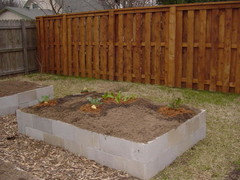
drat55
19 years agoI'm trying to figure out how to configure beds so that deer avoid them too... I get LOTS of them here. Anyone combining this cinder-block idea with deerproofing too?
Diana
Dirt_Girl_McSprout
19 years agoHere I go! I am also about to make my raised beds from cinder blocks, but this is how I am going to vary my beds from those described above to better suit my gopher infested, rain drenched Humboldt county (that is the coastal Northern California Redwoods) backyard.
I plan to use blocks that are half the width of those above -4x8x16". This will save a bit on space and look less cinder blochish - not that there is anything wrong with that. And unlike the big box stores mentioned above, my local store sends strapping young lads to deliver! And I will be waiting with some cool lemonaid... These puppies (the blocks)will be mortared together - I wonder if that will stop the the leakage that everyone has been talking about?
I am going build a little foundataion to set my blocks upon, I think that about 3-5" of cement with a bit of rebar should be enough. I want these beds to be forever!
I am going to line the bottom of my bed with chicken wire to keep those pesky gophers out, and fill it up with my native dirt - river alluvium and priceless, but with some added vermicultie or rice hulls.
Then, to finish off my beautiful beds, I am planning on doing some kind of mosiac along the outside. I have been saving the plates that my dear husband and son have broken over the years - they have added up - and along with some old tile samples, I should be able to mortor on a real saucy mermaid. Wish me luck!lantanascape
19 years agoThat sounds like a great plan, you're much more ambitious than me! Make sure to post pictures when you have them built.
skipp
19 years agoDirt Girl, you may want to try some latex based Drylock sealer for your blocks. You can order the color you want or buy it off the shelf. This is the same product used to seal basement wall blocks.
sweetbrat
Original Author19 years agoI can't believe that this thread is still going from last year! Seeing as how I'm the one that started it, I thought I'd give an update: We're getting ready to install a new bed, and making some updates to the ones we put in last year.
Last year we had put in two 4'x8' beds, one cinderblock high all the way around. There's a small bath in between them. I really liked it last year. I tried planting strawberries in the holes of the blocks, but it didn't work out - they just never grew. I did have some marigolds, and those worked out nicely. But I didn't want to plant every hole, because it makes it hard to access the inside of the bed. So, I planted every third hole, and it didn't work out so well. The holes that didn't have anything planted were completely overrun with weeds, and they were hard to keep under control. So, we're updating those beds. We got some red concrete capstones and some concrete adhesive, and we capped all the tops of them. I thought it might look strange with the grey blocks and the red caps, but it's actually rather nice, plus the red matches the brick in our house. It makes it easier to sit on the blocks, too.
We're also putting in a new bed (3'x18'), and that one will be built the same way. I was very happy with the results I had growing in the beds last year. For my first year gardening, it was amazing. I did't have to water all that often, either. I'll have some pictures to post in a day or two so you can all see what the revamped beds look like.
diggerdee zone 6 CT
18 years agoI found this thread when I did a search on building raised beds. I was looking for an easy way to build them, and the thought of cinder blocks never even crossed my mind. This sounds great!
My question is this. I want to build raised beds on ground that is uneven. The problem is it's pretty much solid rock ledge, so it's not like I can level it. I haven't really gone out there and investigated it, but I'm pretty sure I may have some problems using this method in that area.
Any suggestions for cinder block beds on uneven ground that can't be leveled? Can I level the blocks out some way?
Thanks!
:)
DeeRay Scheel
18 years agoJust scrape out a little of the dirt and loose rock under the main portion of the bed and pathways to build up low spots until level, import sand or clay if necessary to accomplish this. I've had to do something similar on my beds since I'm on a slope.
diggerdee zone 6 CT
18 years agoWell, I can't scrape to level - this is solid rock ledge. The area is not a slope - in general it is a flat, even area. But under the inch or so of soil and moss that is there is solid rock, which has it's ups and downs and crevices, etc. I'll see if I can post a picture tomorrow.
But I can try to build up the area with sand. Will this work? Will the walls of the bed be stable, and will the sand stay put and not wash away?
Thank you!
:)
DeeRay Scheel
18 years agoI wasn't sure if you had enough existing loose dirt on the surface of the ledge to use that or not. Sand and/or "ends" gravel will work.
Use construction sand not play sand if you buy it. Play sand is polished a bit to feel smooth, construction sand (a.k.a. sharp sand or builders sand) is more angular and packs better. Also put some sand on top of the cracks of the blocks after filling the beds so it can wash in to fill the gaps. That grit will provide additional friction to hold the blocks together. Try to place larger rock chips, etc in the crevices.
I have a couple of brick pads as landings at the bottom of the steps up into the house, and it took a few tries to get the drainaige around them right. Once I noticed the pad was sagging a bit, and after working out some bricks I discovered that the underlayment had completely washed out under a sizable portion of the pad, including some narrow areas we actually walked on frequently where it was onlt friction with surrounding bricks holding those bricks in place. You won't have problems with bricks sitting on a sold rock ledge, if they do shift a little you'll figure out a fix easy enough, but cinderblocks don't like to move even on a slick surface.
diggerdee zone 6 CT
18 years agoThank you, Ray, for your help. I really need to go out and inspect. I have to poke around (literally!) and see how deep the soil/moss is throughout this area. I had been considering removing it to try to level, but instead perhaps by using what is there, plus adding sand, I can level this area out enough to build my beds.
Thanks again! I appreciate your time!
:)
Deeasorethumb
17 years agoI'm almost embarrased to ask this, but, if building a cinder block bed, 2 high, does the grass underneath need to be removed or can I just pour the soil/compost over it? the total height will be 16"
immrlizard
17 years agoasorethumb
Just remember grass is like bamboo, it will try to work itself to the top. With that good soil in the bed it will make it easier to do that. With that being said, I didn't remove the grass under mine and it hasn't been too bad. Some people have suggested putting newspaper on top of the grass before, but I don't know how much newspaper will stop it if 12 inches of soil didnt
I really like the idea of using cinder blocks in the bed. Next year when I redo my second set, I may try them if they arent too expensive. They would last the rest of my life and never need to be replaced again.
MollyinVA
17 years agoI just built my first square foot bed out of cinder blocks - will build a second this weekend and plant them both with veggies - mostly tomatoes, peppers and herbs.
I put weed cloth down on the grass, arranged the blocks in a square, and dumped in the dirt. I put the flat concrete pavers on top of the blocks so there's a nice place to sit and work in the garden. It's a bit of a ways down and back up, so I may add a second row of blocks next year. Will see how it all works this year. I never thought about planting the holes. Maybe I'll uncap a couple of blocks and fill the holes with dirt to put in some flowers.
Love this forum!roseyt
17 years agoI'm probably going to use cinder blocks for my raised beds. I plan on using Iron Sulfate to stain the blocks, so they aren't so stark in appearance. You can read about staining with Iron Sulfate at this link. Hoping it'll turn out ok on the blocks as I also have a retaining wall and a patio to stain. :)
Here is a link that might be useful: Staining Concrete with Iron Sulfate
txredkim867
17 years agoWOW what a wonderful place for me to visit today. I have been looking for good ideas for cinderblock gardens for months and today I found some. Today has been very educational. I feel confident that I can go forward with this idea and have a great result. I loved the pictures of the raised beds and got great ideas from them. I also think that part of the fun of gardening is the creativity involed with designing them. To soften the harsh and some what unattractive edges of these style beds is half the fun of designing them in the first place. Thank You All for this forum it was very helpful to me and I hope my experiences with these blocks will as great as all of yours.
diggerdee zone 6 CT
17 years agoGood luck, txredkim! This is the thread where I discovered cinderblock beds, and I went ahead and built them. I love them! They are not the prettiest things to look at, but they are extremely functional, easy to maintain, and just all-round great to work in. I hope you enjoy yours as much as I do!
:)
Deeharleysilo
17 years agoHi all, I used some interlocking concrete edging that was all around the beds at our home when we moved in. We didn't like them as bed edging, so I'll be using them for other things over the years....
{{gwi:1263865}}xessq
16 years agonice info has been posted in here.
just thoguht I would toss in my 3 cents worth.
the wife and I just bought a ton.. literaly.. of very nice decorator commercial grade wall building cinderblocks. Nice 8x8x16 blocks with the one side that has the "hewn" look. Any way, we got them from a stone supplier, they also sell patio pavers and retaining wall blocks. What we found out is that if a builder orders the blocks and has them delivered to a jobsite and there is an "overage" then they return them for a "seconds" credit. the supplier then is only able to sell them as 'seonds" because they have already been on a jobsite. We got them for under a dollar each. (they look sorta like this.... http://picasaweb.google.com/Ambrosiaconstruction/AMBROSIACONSTRUCTION/photo#5133327724187454914 ) except that they are a reddish color.. goes along well with the colors in the paver patio and house.Any way, I just thought I would pass that along... saved us a ton on the blocks.. normal price for "first run" like these are about 3-5 dollars a block.
Good luck with all your gardens this year.
Here is a link that might be useful: picture of decorator block
skagit_goat_man_
14 years agoWhen you use two tiers of blocks for the bed what do you do to keep them from sliding apart? If you sit on them won't the top block shift or fall off? Tom
milenka
14 years agoThank you all so much for the great information. Could some body share some more pictures please , I need some inspiration on how to put them togheter :)
ChrisGilliam39_hotmail_com
13 years agoI'm making mine with 8x12x16 blocks, makes the holes larger. Trying strawberries, carrots, broccoli, onions, and even okra inside the holes. I may even try a few with corn, but I probably won't fill those holes completely. Inside the bed itself is squash, eggplant, cucumber, and a few beans.
erindjames_yahoo_com
13 years agoAt the new house the yard was under at least 4 inches of water most of last summer. I am using blocks this year and plan on going 4 high. I was hoping rebar would be enough to hold it in. and a 6 in layer of stones and sand to keep the water out. does this sound feasible? Also very few in my area attemp to garden at all (flowers included) due to the deer population. Short of a big venison feast, I have to use wire all around these. What would be my best approach for 4 high?
bryan11
13 years agoI'm building three high with 48" rebar on corners and every third brick. I'll fill the rebar hole with concrete to the ground. Some recommended digging footers below the frost line and I thought of using and earth anchor to dig a small hole for the rebar, but that's considerably more work.
My concern is with water leaching out through the concrete, so I'm planning on lining the inside of the bed with heavy plastic so it can only drain at the corners. I don't water our garden now and would prefer to keep doing it that way.
bryan11
12 years agoThe raised bed is finished. The foundation is two layers of 8x8x16 concrete blocks with 6mil plastic underneath. I used 48" rebar and concrete to fill each corner and every third brick. Blocks were attached to each other with Locktite landscape block adhesive. The top layer is 4x8x16 solid concrete blocks. That made the inside width about 48" and made the top look better. Next, the inside and floor was lined with more 6mil plastic so water could only drain from the corners of the bed. Soil was added and seeds planted.
Here is a link that might be useful:
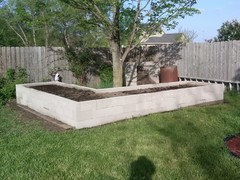
ijensen
12 years agoBryan,
Your bed looks great. We are also in the process of finishing some of these cinder block raised gardens.I strongly considered just dry laying them, but have since decided to motar my blocks. We used the narrow blocks (I'm thinking the 4X8X16 size) and I plan to put the pavers on top as a cap. I went 2 high. As a base, I leveled a 4X4 treated lumber in front, framed with a 2X4 treated lumber on back with 4" of concrete in between. It is a nice solid foundation. On the bed ends, I did use the 8X8X16 size to give me 8 nice pepper plant holes.
Because we have morning glory (I think the real name is bindweed?) that is impossible to control, I actually lined the ground with pit liner. I will then put a layer of rock and the weed barrier on top of the rocks...sorta a double whammie to weeds.
I actually like the look of the block gardens. If nice and straight, they can be an attractive addition to anyone's back yard. I really like the look of the wood base also. My ground did slope alot.
I have also purchased the 16X16 cobble pavers to place around the grounds, with gravel surrounding the area.
We purchased a green house from Lowes this year (already wish it were larger) which sets iin the middleof the garden area. The area is surrounded by a 6" wood fence which serves at a wind barrier.
I'm excited to have it finished up and ready to plant. It has been a weird year in Utah...I always get a good freeze the second week of June. At 7000 feet, that's not surprising..:0)
MatthewLangholtz
12 years agoDoes anyone have experience with the 'lightweight cinder blocks'? They are also 8' tall x16' long, but they are thinner, available in 4' or 6' thicknesses, saving $ and lifting. Seems like I could reinforce with rebar if necessary?
Here is a link that might be useful: Fence block?
jolj
12 years agoJonhugh has a youtube or two video also.
Here is a link that might be useful: Jon concrete beds
maganoonee
12 years agoI see that this thread is still strong after so many years. Awesome! I am starting a cinder block garden this coming spring. I'm actually purchasing 360 blocks later this afternoon! It's going to be a lot of work to get them home, but I found a reclamation yard selling brand new blocks for a $1 a piece which is saving me about $180. I originally was going to buy from Home Depot @ $1.52 a block.
I will post pictures after all is said and done, but I wanted to share a link of a fantastic cinder block garden done by a woman and her friends and family. I find the mosaic tile to be quite nice looking and not to mention a great project for the kids! If you can find glass/tile in bulk from some tile companies trying to get rid of broken product, it's quite reasonably priced. Cheers and I will post pix soon. :)
Here is a link that might be useful: Whimsical Raised Beds
gingergrl
12 years agomaganoonee...i'm so glad u posted the link to whimsical. after i decided to use cinder blocks for my raised garden beds, i googled some ideas and found that link. we are going to prime and paint the blocks instead of using mosaics, though, and have our kids and neighborhood kids come over and add their own artwork.
what could be better than gardening and art combined?!! can't wait to see your pics...great ideas up here.
smichel
11 years agoHere is my 1st attempt at using cinder blocks for a veggie garden bed:
My new "house" had a blank slate for a yard :-(
After living here for almost a year - it was time to start "blooming".
Texas A&M University has a GREAT school-wide community service project called "The Big Event". Every year, local people can sign up to have students come to help with projects around your home. I signed up and on a Saturday in March, 6 students came and helped me build a raised vegetable garden bed made of cinder blocks.
HereâÂÂs a picture of what they helped me buildâ¦
Now I just have to get some veggies planted in there!
.... Almost a month later, I finally have some real growth in the garden. Kentucky Wonder pole beans have grabbed onto the jute hanging on my make-do trellis and the cucumbers are looking for a place to climb. I'll work on a trellis or tepee for them next. I need some help with the tomatoes though �" they look a bit sickly!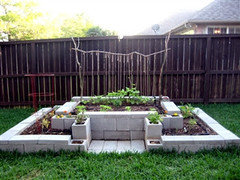

TehachapiGal
10 years agoA mention that vermiculite is no longer widely used because much of it is contaminated with asbestos and cancer causing. Libby Montana operated a vermiculite mine, with deaths attributed to the vermiculite ore. They eventually closed. I use perlite but the dust is stifling to work with if breathed.
http://www.libbyasbestos.org/libby/libby.cfmmaternut
10 years agoWhat a interesting post. Now if I could just copy I could sell a book. Thanks to everyone. Been thinking about cinder blocks for a couple of years, you folks just made up my mind.
tljack
9 years agoLots of good information here - a great thread. My plot is on a hill that has some fill to it, so I wanted footings, blocks mortared in place and then for both aesthetic and structural reasons an SBC (surface bonding cement - quikwall).
This is completely still under construction but what brought me here was looking into a mortar or (latex based drylock sealer). I really do not like the look of the cinder block and like a more stucco type finish (but stucco does not work here in Western WA).
Any ideas for paint (right now I am leaning towards no paint for healthy gardening reasons), but I thought I would put out what I am doing and get some feedback.
These are new beds but if I can answer any questions (I am a novice) about what I did I would be happy to share.

tljack
9 years agoLots of good information here - a great thread. My plot is on a hill that has some fill to it, so I wanted footings, blocks mortared in place and then for both aesthetic and structural reasons an SBC (surface bonding cement - quikwall).
This is completely still under construction but what brought me here was looking into a mortar or (latex based drylock sealer). I really do not like the look of the cinder block and like a more stucco type finish (but stucco does not work here in Western WA).
Any ideas for paint (right now I am leaning towards no paint for healthy gardening reasons), but I thought I would put out what I am doing and get some feedback.
These are new beds but if I can answer any questions (I am a novice) about what I did I would be happy to share.
{{!gwi}}
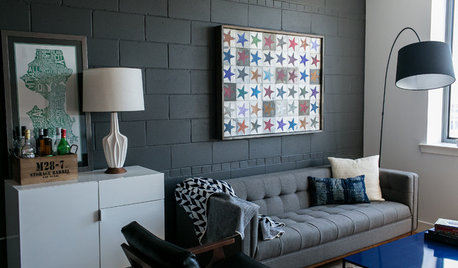
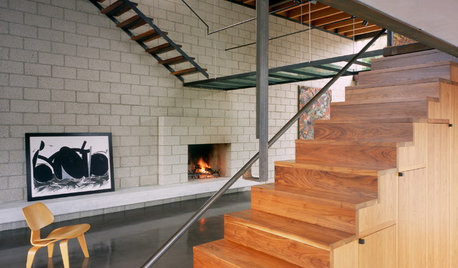
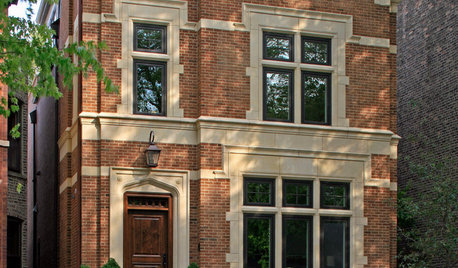

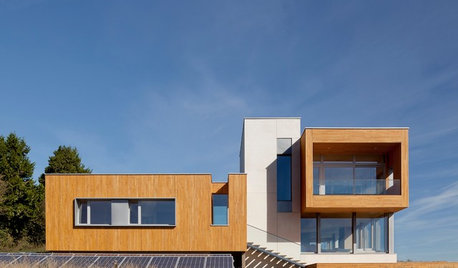
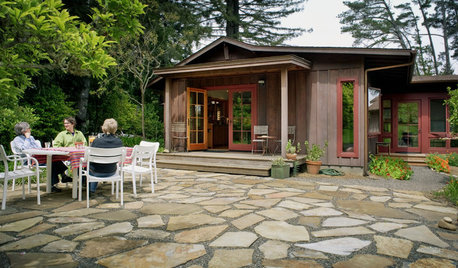

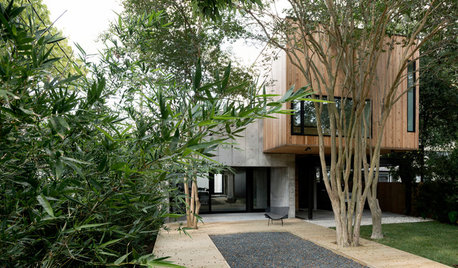
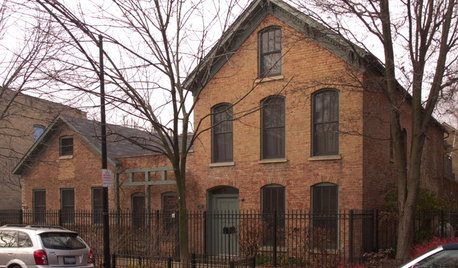







kittysmith